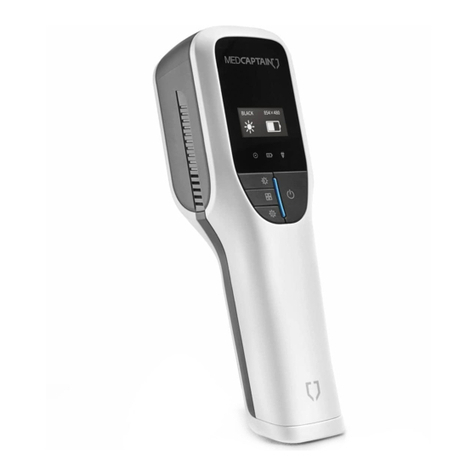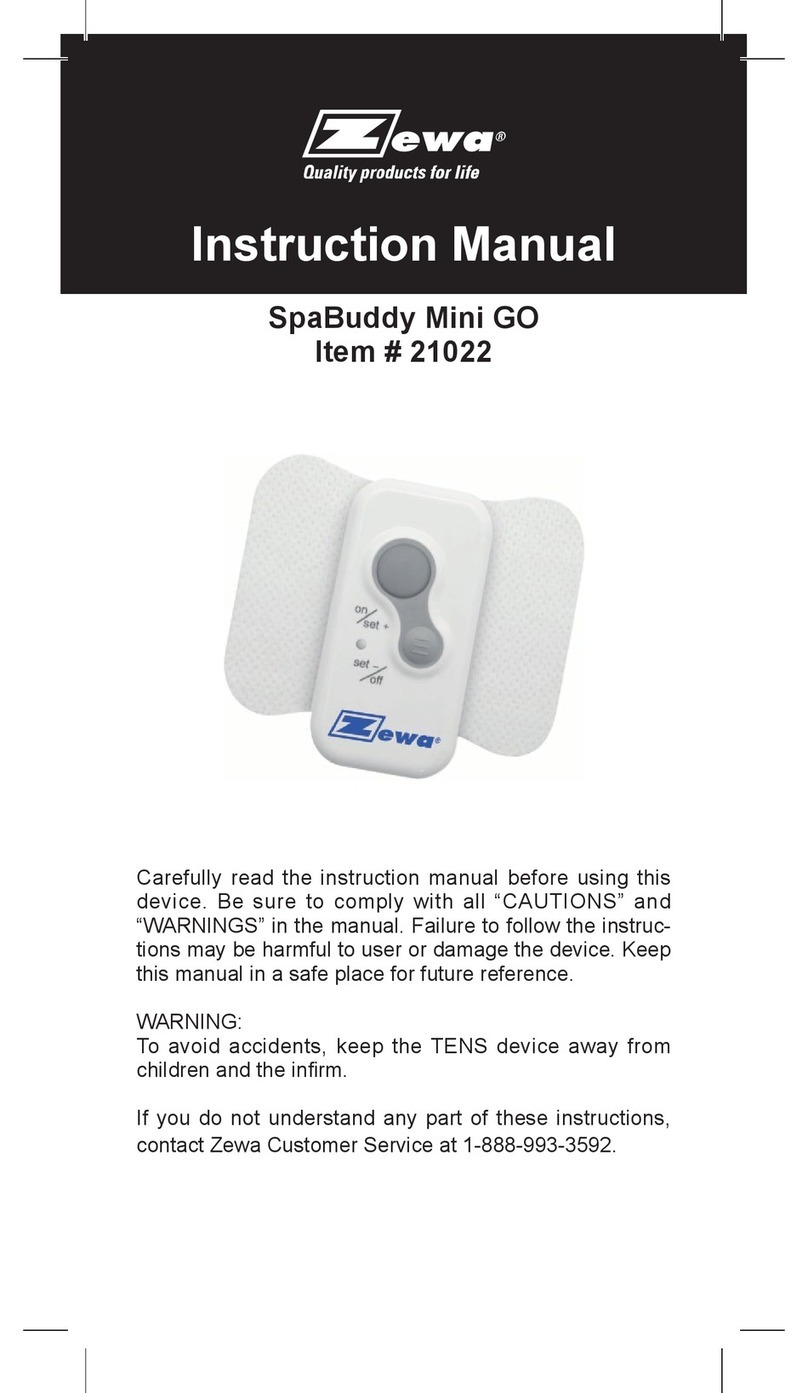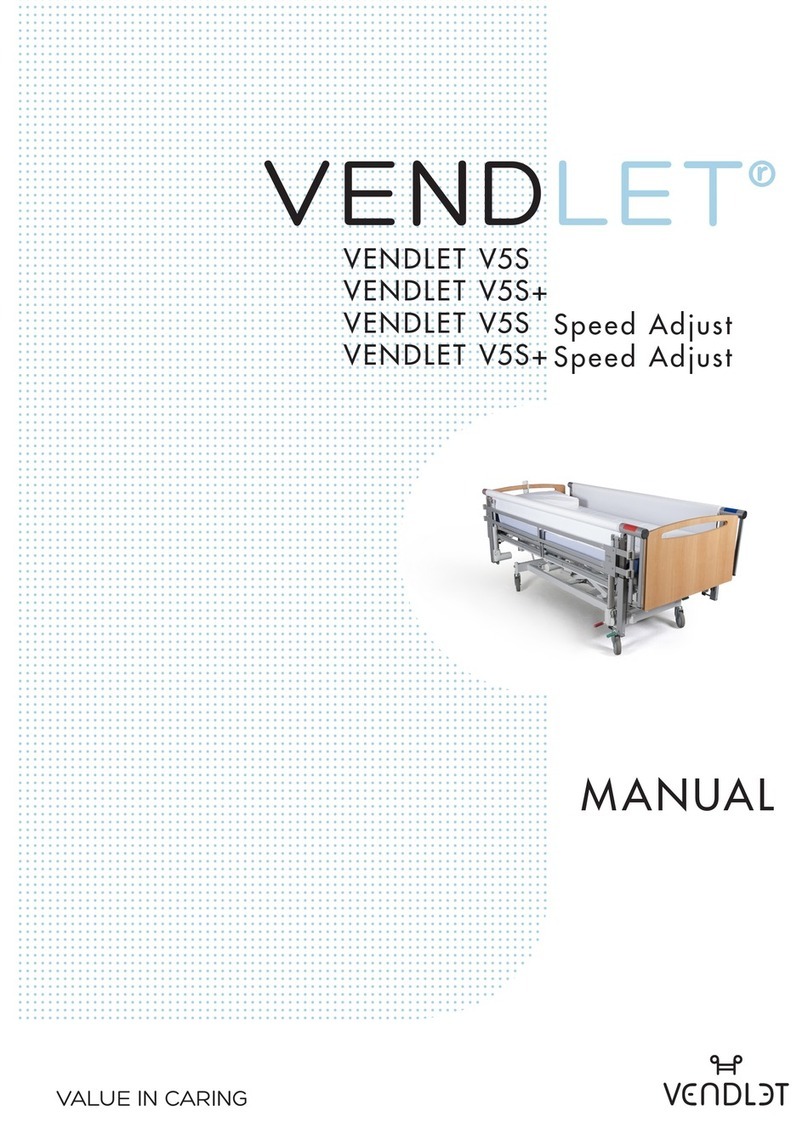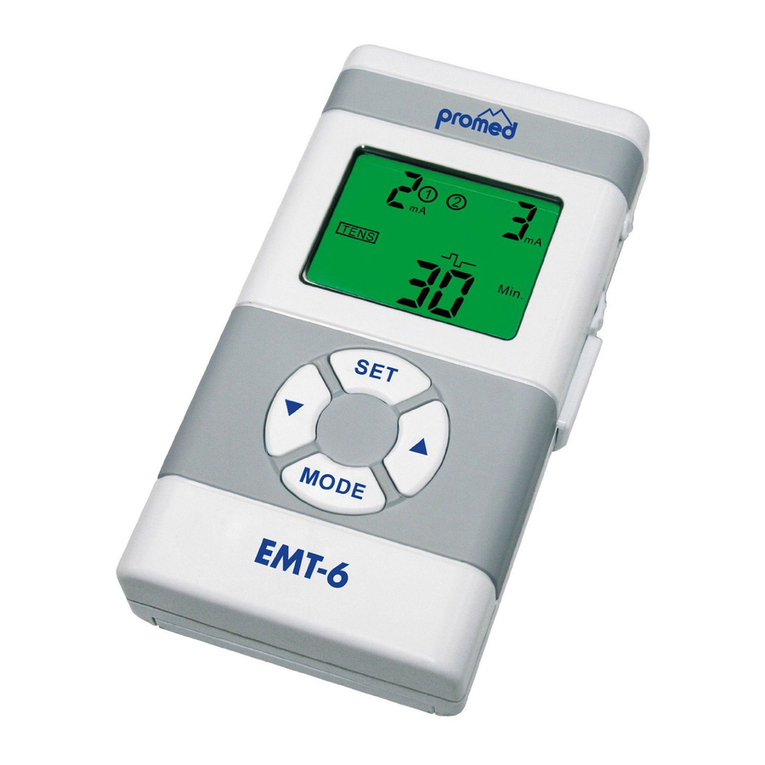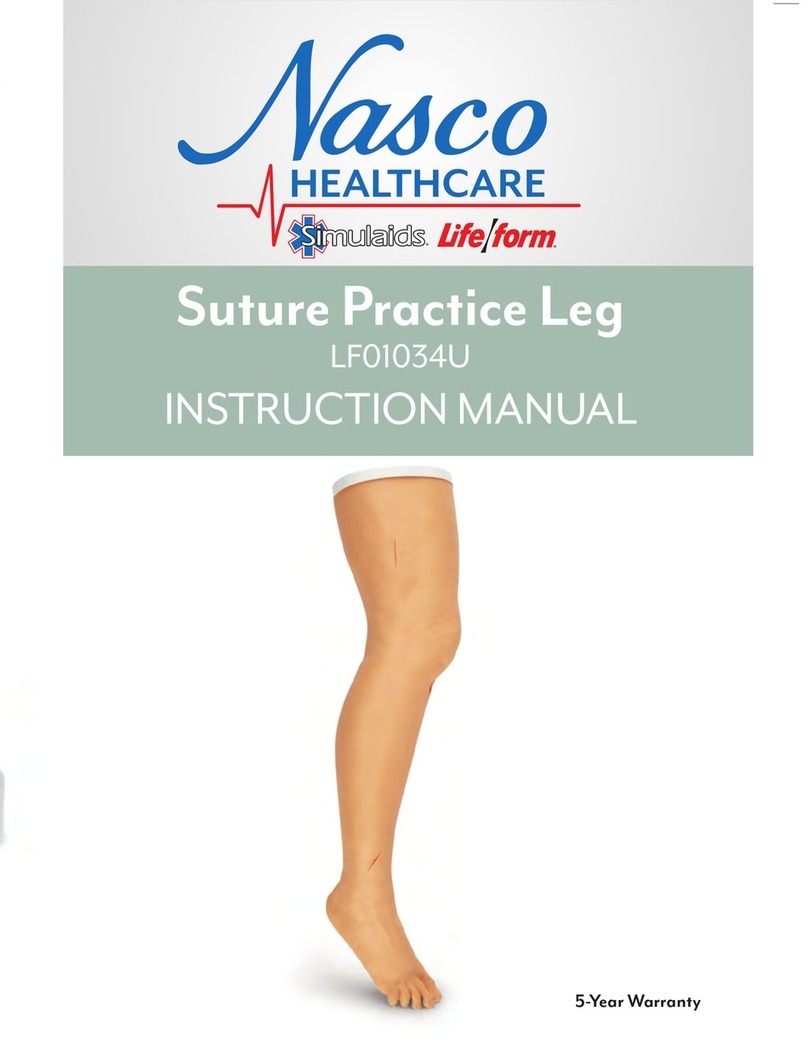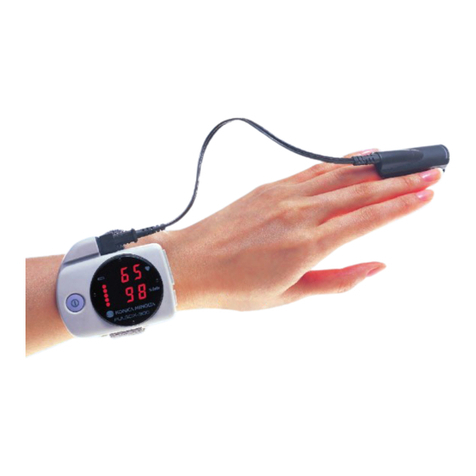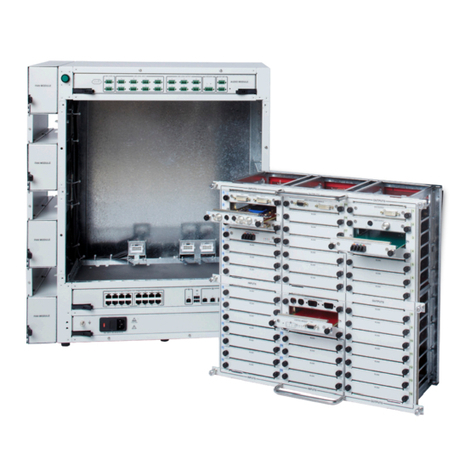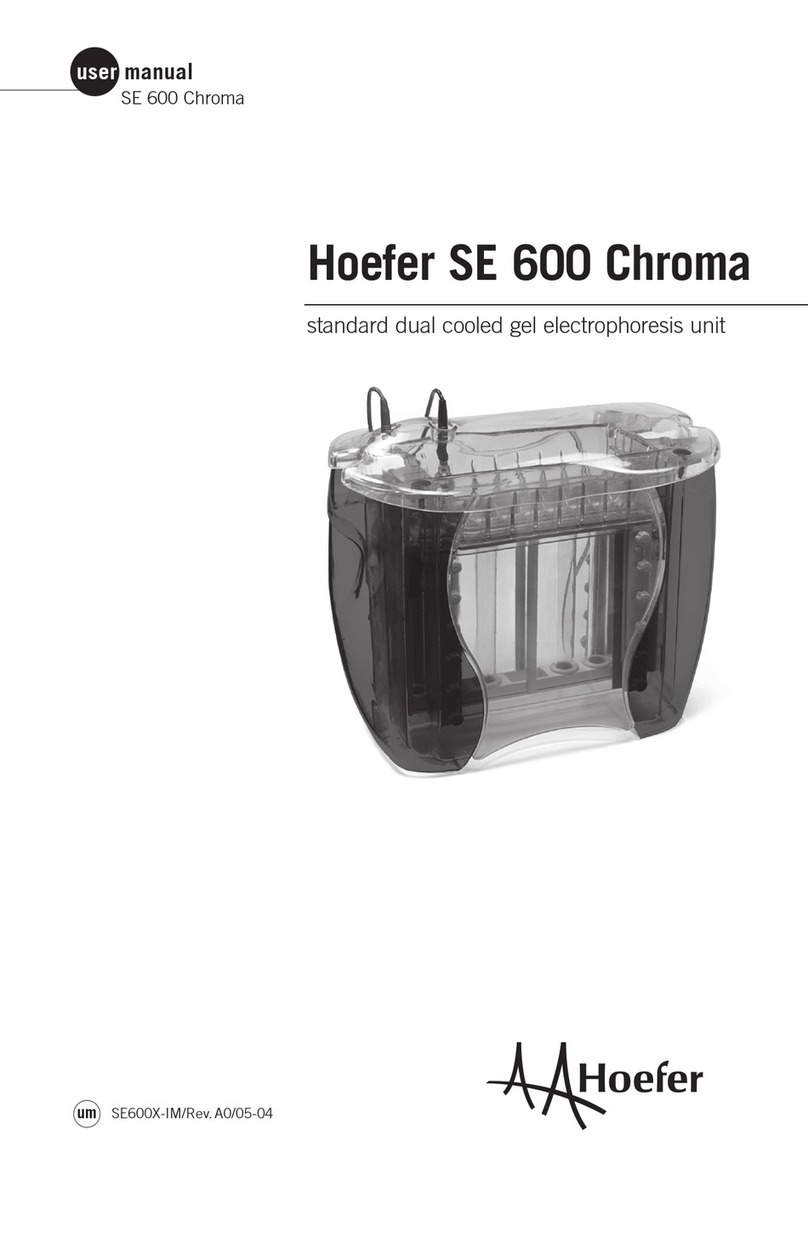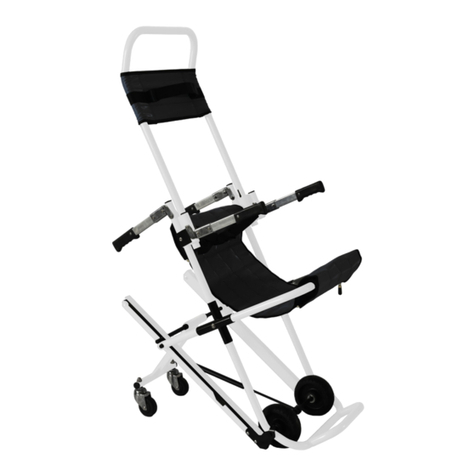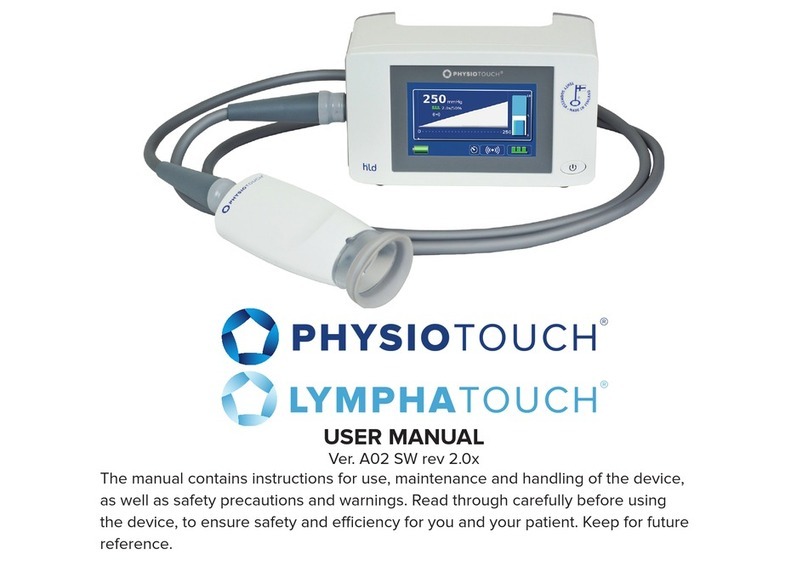Cheetah Medical Starling SV User manual

R-IFU-05 /Revision 3
Starling™ SV
User Guide

S T A R LI N G S V S Y S T E M
UserGuide
In the US:
Cheetah Medical, Inc.
600 SE Maritime Ave Suite 220
Vancouver, WA 98661
USA
Toll free: (+1) 866-751-9097
Telephone: (+1) 360-828-8685
Fax: (+1) 360-718-8154
In Europe and Asia
Cheetah Medical (UK) Limited
1, Irmar House
59, Cookham Road
Maidenhead
Berkshire SL6 7EP
United Kingdom
Telephone: (+44) 1628 636806
Fax: (+44) 1628 788802
E-mail: cheetah@cheetah-medical.com
Web Site: www.cheetah-medical.com
Cheetah Medical 2016

TableofContents
Conventions used in this manual.........................................4
1.0 Introduction.....................................................................6
1.1 Introduction.....................................................................6
1.2 General Description........................................................7
1.3 Front and Buttons...........................................................7
1.4 Rear and cables................................................................8
1.5 Specifications.................................................................11
1.6 NIBP...............................................................................12
1.7 Bedside Care ..................................................................22
1.8Label.................................................................................22
1.9 Battery Mode .................................................................23
1.10 Warnings and Precautions..........................................23
Warnings...............................................................................23
Precautions...........................................................................24
1.11 Cleaning and Disinfecting the Starling SV Device..25
1.12 Special Patient Populations........................................25
1.13 Indications for Use......................................................26
1.14 Limitations of Use.......................................................27
1.15 SpO2.............................................................................28
2.0 Screens Overview..........................................................33
2.1 Start Up Screen..............................................................33
2.2 Menu Screen ..................................................................34
2.3 New Patient Screen.......................................................35
2.4 Existing patient..............................................................36
2.5 Run Screen.....................................................................37
2.6 Trend Display Screen....................................................43
2.7 Tabular Display Screen.................................................44
2.8 Protocol Dashboard Display screen............................46
2.9 Hemodynamic Dashboard Screen...............................46
2.10 Settings Screen.............................................................47
2.11 Set Option....................................................................50
2.12 General Options..........................................................51
2.13 Test Options................................................................52
2.14 NIBP Options .............................................................53
2.15 SpO2 Options..............................................................54
2.16 Art Options..................................................................55
2.17 Connectivity.................................................................56
2.18 Network Configuration.............................................57
2.19 Date and Time.............................................................58
2.20 Device Mode................................................................59
2.21 Service Mode Screen...................................................60
2.22 Live Demo and Demo Screens..................................61
2.23 Shut down Screen........................................................62
2.24 WI-FI options..............................................................63
3.0B Basic Functions...........................................................64
3.1 Saving a New Patient ....................................................64
3.2 Performing a Session ....................................................64
3.3 Viewing Test Results.....................................................67
3.4 Entering Events.............................................................69
3.5 Calibrating the Touch Screen.......................................71
4.0 Settings & Advanced Functions ..................................72
4.1 Height Units...................................................................73
4.2 Weight Units..................................................................73
4.3 Electric Grid ..................................................................73
4.4 Audible Alarm................................................................73
4.5 Date Format...................................................................73
4.6 Time Format..................................................................73
4.7 Test Type........................................................................74
4.8 Sample Interval..............................................................74
4.9 TFCd...............................................................................75
4.10 NIBP.............................................................................75
4.11 NIBP Operation Mode...............................................76
4.12 NIBP Time Interval....................................................76
4.13 NIBP Initial Inflation Pressure..................................76
4.14 Date and Time Setup..................................................78
4.15 Connectivity Wizard....................................................78
4.16 Networking Wizard.....................................................79
4.17 Hgb Posting Period.....................................................80
4.18 SpO2 Operation Mode...............................................80
4.19 Art Operation Mode...................................................81
6.0 Measurements Short Description................................82
6.1 CO...................................................................................82
6.2 CI.....................................................................................82
6.3 HR...................................................................................82
6.4 VET ................................................................................82
6.5 dX/dt..............................................................................82
6.6 SV....................................................................................82
6.7 SVI ..................................................................................83
6.8 SVV.................................................................................83
6.9 TFC.................................................................................83
6.10 TFCd.............................................................................83

6.11 TFCd0...........................................................................83
6.12 BP..................................................................................83
6.13 MAP..............................................................................83
6.14 TPR...............................................................................84
6.15 TPRI .............................................................................84
6.16 CP..................................................................................84
6.17 CPI................................................................................84
6.18 Z0..................................................................................84
6.19 DO2I ............................................................................84
6.20 SpO2.............................................................................84
6.21 Hgb ...............................................................................84
6.22 SBP .............................................................................84
6.23 DBP.............................................................................85
7.0 Troubleshooting............................................................86
7.1 Error Messages............................................................86
7.2 Warning Messages.......................................................90
7.3 Other Problems...........................................................90
8..0 SERVICE AND MAINTENANCE.........................93
8.1 Cleaning..........................................................................93
8.2 Fuse Replacement .........................................................94
8.3 Chargeable Batteries......................................................94
8.4Electromagnetic Compatibility – Manufacturer Declaration
...............................................................................................95
9.2 Equipment and Accessories Inventory.....................102
Returning Parts under Warranty......................................102
Shipping Parts....................................................................103

5
Conventions used in this manual
WARNING Indicates conditions or practices that could lead to patient injury,
illness, or death
CAUTION Indicates conditions or practices that could damage the equipment or
other property.
Note Provides additional important information.
Consult operating instructions
Manufacturer
Temperature range
Relative humidity range
Atmospheric Pressure range
Use by
Do not reuse
Latex Free
European approval mark
Authorized representative in the European Community
Serial Number
Type BF Applied Part
Store in a cool and kept away from direct sunlight place
Store in a dry place
Do not open
Do not dispose of, contact for recycling
FCC Symbol
Non-ionizing electromagnetic symbol

5
Patient Information Bar - Appears on all Run screens. This bar holds all of the
patient's info as it was inserted into the system, such as: ID, Name, Gender, Age,
Weight, Height and BSA. The Patient Information Bar also holds the Test Type Icon
('R' for rest testing or 'S' for stress testing).
Run Bar - Appears on all Run screens. This bar holds the Study Refresh Clock,
Alarm status icon, Test status icons (play, pause or stop) and the Message Display
area.
Menu Bar – Appears on all of the STARLING SV's screens. This bar holds the
Screen Name, Operation Help line, Date, Time and Battery status.
Note In order to reach the sub menu – first enter the screen's pop-up menu by
clicking the STARLING SV's Back button. Then, either click the STARLING SV's
OK button or use its Right arrow key to enter the sub menu.*All icons described according
to order of appearance - from left to right

6
1.0 Introduction
1.1 Introduction
The Starling™ SV System is a portable, non-invasive cardiac output (CO)
monitoring device based on BIOREACTANCE® technology. It also
measures Heart Rate (HR), Stroke Volume (SV), Stroke Volume Variation
(SVV), Ventricular Ejection Time (VET), Mean Arterial Pressure (MAP),
Systolic Blood Pressure (SBP), Diastolic Blood Pressure (DBP), Blood
Oxygenation (SpO2) and Thoracic Fluid Content (TFC). In addition the
system calculates clinical parameters such as Cardiac Index (CI), Stroke
Volume Index (SVI), Total Peripheral Resistance (TPR), Total Peripheral
Resistance Index (TPRI), Cardiac Power (CP), Cardiac Power Index (CPI),
Oxygen Delivery Index (DO2I), Thoracic Fluid Content delta (TFCd)
and Thoracic Fluid Content delta from baseline(TFCd0) based on the
above measured parameters or based on a manually entered parameters
such as manually entered Hemoglobin (Hgb), manually entered blood
oxygenation (SpO2) or manually entered Mean Arterial Pressure (MAP).
The NIBP functionality measures and displays systolic, diastolic, and mean
arterial pressures. The SpO2 functionality measures and displays SpO2.
The Starling SV®Operator’s Manual contains instructions and
information for the operation and maintenance of the Starling SV System.
A thorough understanding of the system controls and connections is vital
for instrument operation. It is therefore essential to read this manual
carefully before attempting to use the Starling SV System, in order to
ensure optimal performance and trouble free service life. This manual
should be retained for future reference.
Chapter
1

7
1.2 GeneralDescription
The Starling SV System dimensions are:
Height: 220 mm
Width: 290mm
Depth: 190mm
Total Weight: 4.3 Kg
1.3 FrontandButtons
On the front there is an 10.4" LCD screen, knob and three buttons. . In order to
turn the unit on, press continuously on the power button until it turns Green
or Orange and the Cheetah Logo is prompted on the screen; in order to turn the
unit off, use the Shut Down command on the main menu (section 2.22).
Alternatively, pressing the power button continuously for several seconds will
also turn the unit off, however this shut down method is discouraged because
some test information may not be saved. Use the STARLING SV's knob in order
to choose commands from the menu, to change measurements' display during a
test. In addition, the knob can be used to browse and look up values within fields,
to move the cursor between fields, to browse test segments when reviewing
patient test results. The STARLING SV's Back button serves to operate the
pop-up menu and to return the cursor to previous placement. The menu
button opens and closes the menu display when pressed.
Figure 1.1
Starling SV System Front Panel

8
TouchScreen:
In addition to the three buttons and knob, the STARLING SV System is equipped
with a touch screen.
Navigation in Menus
Touch a menu option to immediately select it. To open the Side Menu with the
Touch Screen, touch the Menu Name on the side of the screen.
Browsing Through Trends and Table Display
To browse through the trends and tables presented by the monitor, touch the arrows
of the dedicated slider. For faster browsing drag the Slider body. It is also possible to
sweep the finger over the trends to the direction required.
Browsing Through Events
In the Numerical and Trends displays skip between events by touching the Events
Browsing Tool on the screen
Changing the trends scale
In order to change the scale of the trends move two fingers apart or towards each
other. It is also possible to change the trends scale by choosing Time Scale
from the Side Menu View Option and then the time scale required.
1.4 Rearandcables
Observe the rear side and the right side of the monitor box:

9
Figure 1.2
Back panel of the Starling SV
Figure 1.3 Front and side of the Starling SV

10
In the side of the device there are five cable sockets:
1. Starling SV Patient Cable connector – the connector is intended for the Starling
SV Patient Cable. The other end of the patient cable should be connected to the
Starling SV Sensors which are applied to the patient’s body as described in the
section 'Performing a Test' (section number 3.2).
Note The Starling SV Patient Cable is connected to the Starling SV using an
ODU type connector. In order to connect it push the connector and turn it
clockwise until it’s locked in order to prevent disconnection that would lead to loss
of monitoring function.
WARNING It is advised to clean the Starling SV Patient Cable between
patients in order to prevent the transfer of infectious diseases (see in Section 8.2.
Service and Maintenance, Cleaning)
2. NIBP cuff connector – Connect the NIBP cuff to the monitor using the NIBP
connector (please refer to figure 1.2).
3. SpO2 connector – Connect the SpO2 Sensor to the monitor using the SpO2
connector (please refer to figure 1.2).
In the rear of the monitor the following connector are preset:
1. IBP connector – For future functionality.
2. Power socket – standard electric power socket. The device can also function on its
internal chargeable batteries. Connecting this cable to an electric source will supply
the monitor from the main grid and charge the batteries.
3.USB port – connecting a standard USB cable allows the user to download results
of previous tests stored in the Starling SV to the Starling SV EMR PC application.
In order to perform these actions it is necessary to install the Starling SV EMR PC
software to a PC. The software CD comes with every new monitor and can also
be accessed by contacting a Cheetah Medical Service representative. The USB
port also enables various technical operations such as uploading of software
upgrades.
4.Serial port – To connect the monitor to an external EMR serial connection.
5.Ethernet – To connect the monitor to an external EMR Ethernet connection.

11
1.5 Specifications
Skin Voltage Tolerance: ±300 mV
Frequency Response: 8Hz
Time Constant: 0.125 Sec
CMRR: 70db
Filter: 75KHz
Safety Requirements: According to IEC/EN 60601-1 standard. Class I
Equipment BF type applied part.
Rated Voltage/Current: Power switch supply 100V to 240V
Rated frequency 50/60 Hz.
Fuses: 2 X T2AL250V
A/D converter at 12 bit (2.5 mV LSB).
Sample rate 500 per sec.
Features Hemodynamic display options
Height/Weight units
Dedicated Starling SV Electronic Medical Records
interface (XlS PDF & XML file formats, Password
Protection)
Hemodynamic status report with visit-to-visit data
Clinical Protocol Wizards
Event Management
Touch Screen control
Serial and Ethernet connections
AmbientTemperatureandHumidity:
Operation condition: 10-40°C/ 50-104°F, 50-75% RH
Atmospheric pressure: 700hPa to 1060hPa
Storage condition: 0-50°C/ 32-122°F, 50-75% RH
Delivery condition: 0-50°C/ 32-122°F, 50-75% RH
TechnicalCharacteristicsofAcquisitionModule
Isolated preamplifier in accordance with IEC 60601-1 standard.
Note The Starling SV is not defibrillator proof.

12
1.6 NIBP
Terminology:
Oscillometry
The oscillometric method of blood pressure measurement is a non-invasive method
that monitors the amplitude of cuff pressure changes during cuff deflation to
determine arterial blood pressure. The cuff pressure is first elevated above the patient
systolic blood pressure level and the cuff begins to deflate at a certain rate. The initial
rise in amplitude of these pressure fluctuations during cuff deflation corresponds
closely to the systolic blood pressure. As the cuff is further deflated, these pressure
fluctuations increase in amplitude until a peak is reached which is usually referred to as
the mean arterial pressure (MAP). As cuff deflation continues, the diastolic pressure
can be determined based upon the rapidly diminishing amplitude of the pressure
fluctuations. Thus systolic, MAP and diastolic blood pressures can be accurately
obtained by supervising the pressure fluctuations while controlling the cuff deflation
rate.
mmHg
Millimeters of Mercury, which is the most common unit of measure for pressure in
non-invasive blood pressure.
bpm
Beats per minute, which is the most common unit of measure for pulse rate.
Introduction:
The NIBP module of the STARLING SV device is an oscillometric blood pressure
system. The module is designed to take blood pressure measurements on demand.
After each blood pressure measurement, the Module will discard the previous blood
pressure results. All Module operating parameters will reset to default values at power-
up. All Module blood pressure values are discarded when the Module is reset
PopulationsthatmayusetheNIBPfunction:
For pediatric and adult patients, blood pressure measurements made with the
Advantage OEM BP Module Series are equivalent to those obtained by trained
observers using the cuff/stethoscope auscultatory method within the limits prescribed
by ANSI/AAMI SP10 (mean error difference of ± 5 mmHg or less, standard
deviation of 8 mmHg or less).
Blood pressure measurements determined with this device are equivalent to those
obtained by a trained observer using the cuff / stethoscope auscultation method,
within the limits prescribed by the American National Standard, Electronic or
automated sphygmomanometers. The NIBP Module performance with common
arrhythmias, such as atrial or ventricular premature beats or atrial fibrillation, has been
verified by use of a patient simulator.

13
For neonatal patients, blood pressure measurements made with the Advantage OEM
BP Module Series are equivalent to those obtained by intra-arterial blood pressure
devices within the limits prescribed by ANSI/AAMI SP10: 1992 & 2002 (mean error
difference of ± 5 mmHg or less, standard deviation of 8 mmHg or less).
The automatic selection between the 3 NIBP population modes is performed when
the entering the patient demographic information as follows:
Adult – Age above 12 years (Automatic, default)
Pediatric – Weight above 7Kg and age 12 and below (Automatic)
Neonate – Weight 2.5Kg and below (Automatic)
NOTE The user shall be given the option to select Neonate or Pediatric NIBP
population mode if the patient weight is between 2.6Kg and 7Kgs.
NOTE in Neonate mode the following ranges apply:
Systolic 40-130mmHg
MAP 26-110mmHg
Diastolic 20-100mmHg
Initial Inflation Pressure 90mmHg (default)
Variable from 60 to 140mmHg
Warnings&Precautions
This device should not be used when oscillometric pulses may be altered by other
devices or techniques such as External Counterpulsation (ECP) or Intra Aortic
Balloon Pump Counterpulsation.
DO NOT use the NIBP module for any purpose other than specified in this
manual without written consent and approval from Cheetah Medical.
DO NOT use the device in the presence of flammable gaseous anesthesia agents
because of flame hazard.
DO NOT attach the cuff to a limb being used for IV infusions or any other
intravascular access, therapy or an arterio-venous (A-V) shunt. The cuff inflation can
temporarily block blood flow, potentially causing harm to the patient.
DO NOT apply the BP cuff over a wound as this can cause further injury.
DO NOT For patients that have had a mastectomy, cuff should be applied to
opposite arm.
CAUTION Substitution of a component different from that supplied may result in
measurement error. Repairs should be undertaken only by personnel trained or
authorized by Cheetah Medical. Do not modify this equipment without authorization
from Cheetah-Medical.

14
CAUTION Accuracy of any blood pressure measurement may be affected by the
position of the subject, his or her physical condition and use outside of the operating
instructions detailed in this manual. Interpretation of blood pressure measurements
should be made only by a physician or trained medical staff.
CAUTION All air hoses and cuffs used to connect the patient to the module must
be approved by Cheetah Medical. Hoses of a certain material and/or durometer may
cause the module to perform in an improper fashion. Also, cuffs that are extremely
small or large in volume may cause errors to occur depending on the BP mode
selection. Air hoses as well as cuffs are offered as accessories from Cheetah Medical.
CAUTION If the blood pressure cuff is on the same limb as monitoring
equipment (i.e., pulse oximeter probe), the pressurization within the cuff can cause
temporary loss of function of the monitoring equipment.
CAUTION If the blood pressure cuff is on the same limb as a pulse oximeter
probe, the oxygen saturation results will be altered when the cuff occludes the brachial
artery.
CAUTION To obtain accurate blood pressure readings, the cuff must be the
correct size, and also be correctly fitted to the patient. Incorrect size or incorrect
fitting may result in incorrect readings.
CAUTION When a cuff is used on a patient for an extended length of time, be
sure to occasionally check the limb for proper circulation.
CAUTION Intra-arm differences vary between people. Do not assume that
measurements from both arms are same.
CAUTION The module may not operate correctly if used or stored outside the
relevant temperature or humidity ranges described in the Performance specifications.
CAUTION Intended patient population include adult, pediatric and neonate
patients. Safety and effectiveness on pregnant women and neonates have not been
tested.
CAUTION For neonate populations, the clinical effectiveness of this device has
not been established in the presence of dysrhythmias. Arterial reference sites included
femoral, umbilical and radial arteries.
NOTE For adult and pediatric populations, K5 was used to clinically validate
diastolic pressure.
CAUTION Check that operation of the unit does not result in prolonged
impairment of the circulation of the patient.

15
CAUTION Neonates measurements must always use a 3 meters patient hose
in order to avoide overpressure errors caused by a lack of air volume within the
overall pneumatic system.
CAUTION A compressed or kinked connection hose may cause continuous cuff
pressure resulting in blood flow interference and potentially harmful injury to the
patient.
CAUTION Too frequent BP measurements can cause injury to the patient due to
blood flow interference.
CAUTION Pressurization of the BP cuff can temporarily cause loss of function of
simultaneously used monitoring equipment on the same limb
WARNING Regarding the effect of blood flow interference and resulting harmful
injury to the PATIENT caused by continuous CUFF pressure due to connection
tubing kinking.
WARNING Regarding the need to check (for example, by observation of the limb
concerned) that operation of the AUTOMATED SPHYGMOMANOMETER does
not result in prolonged impairment of the circulation of the blood of the patient.
AdverseReactions
Allergic exanthema (symptomatic eruption) in the area of the cuff may result,
including the formation of urticaria (allergic reaction including raised edematous
patches of skin or mucous membranes and intense itching) caused by the fabric
material of the cuff.
Petechia (a minute reddish or purplish spot containing blood that appears on the skin
surface) formation or Rumple-Leede phenomenon (multiple petechia) on the forearm
following the application of the cuff, which may lead to Idiopathic thrombocytopenia
(spontaneous persistent decrease in the number of platelets associated with
hemorrhagic conditions) or phlebitis (inflammation of a vein) may be observed.
CuffSelection&Placement
It is important to select the cuff size that is appropriate to the diameter of the patient's
upper arm. Use the Range Lines on the inside of the cuff to determine the correct size
cuff to use.
Wrap the cuff around the arm making sure that the Artery Marker is aligned over the
brachial artery (as shown in Figure 1.3). If possible, do not wrap the cuff over the
patient's clothing. The cuff should fit snug to the patient's arm for maximum
oscillometric signal quality. An appropriate sized cuff should be placed on the non-

16
dominate arm where the lower edge of the cuff is located 2cm above the antecubital
fossa (interior bend of the elbow).
Figure 1.3
NIBP Cuff Placement
Ensure that the air hose from the monitor to the cuff is not compressed, crimped or
damaged.
The midpoint of the subject's upper arm should be supported at heart level for
proper measurement accuracy. When the cuff is below heart level, measurement
results may be higher and when the cuff is above heart level, measurement results
may be lower than comparative results obtained at heart level.
Please remember that using a cuff that is the wrong size may give false and
misleading results.
Note The NIBP module is designed to work with SunTech cuffs and hoses.
The use of cuffs and hoses not supplied by Cheetah-Medical or SunTech may
compromise performance and accuracy.
Note The initial inflation pressure will be selected via the "Initial Inflation"
option that is located on the NIBP Settings' screen unless automatically specified
by the NIBP patient population mode (Neonate, Pediatric).
CuffsizesavailableforusewiththeStarlingSV:
Part #
Description/Size
Range
(cm)
Bladder
(cm)
98-0080-04
All-Purp, Small Adult
17-25
9.8x20.3
98-0080-05
All-Purp, Small Adult Long
17-25
9.8x20.4
98-0080-06
All-Purp, Adult
23-33
13x27.5
98-0080-07
All-Purp, Adult Long
23-33
13x27.6
98-0080-08
All-Purp, Large Adult
31-40
16.3x33
98-0080-09
All-Purp, Large Adult Long
31-40
16.3x33
98-0080-10
All-Purp, Thigh
38-50
20x40

17
NIBPModulePerformance
Method of Measurement
Oscillometric. Diastolic values correspond to Phase 5
Korotkoff sounds.
Blood Pressure Range:
Systolic:
ADULT
40-260 mmHg
PEDIATRIC
40-230 mmHg
NEONATE
40-130 mmHg
MAP:
ADULT
26-220 mmHg
PEDIATRIC
26-183 mmHg
NEONATE
26-110 mmHg
Diastolic:
ADULT
20-200 mmHg
PEDIATRIC
20-160 mmHg
NEONATE
20-100 mmHg
Pulse Rate Range:
30 to 220 BPM (Beats Per Minute)
Pulse Rate Accuracy:
± 2% or ± 3 BPM, whichever is greater
Cuff Deflate Rate:
Deflation step size varies with heart rate, cuff pressure
and cuff volume.
Initial Inflation Pressure:
ADULT:
160 mmHg (Default)
Variable from 120 to 280 mmHg
PEDIATRIC:
140 mmHg (Default)
Variable from 80 to 280 mmHg
NEONATE:
90 mmHg (Default)
Variable from 60 to 140 mmHg
Clinical Accuracy:
Meets accuracy requirements of ANSI/AAMI SP10,
EN1060-4 and ISO 81060-2.
Pressure Transducer Accuracy:
±3mmHg between 0 mmHg and 300 mmHg for
operating conditions between 0°C and 50°C
Recommended Frequency of
Pressure Transducer Calibration:
The pressure transducer calibration should be verified on
a yearly interval
Operating Conditions:
0°C to 50°C, 15% to 95% non-condensing humidity
Storage Conditions:
-20°C to 65°C, 15% to 90% non-condensing humidity
Altitude:
Measurement accuracy is not affected by altitude
Startup Initialization Period:
7 seconds
Minimum time between
commands:
50 milliseconds
Patient Safety:
Internal operating software ensures that:
Maximum initial inflation time is limited to 75
seconds
Duration of blood pressure reading is limited to 130
seconds (Adult/Peds mode)
120 seconds (Adult/Peds Motion Tolerant mode)
75 seconds (Neonate mode)
Additional redundant safety circuitry oversees normal
operation and will override to abort a reading if:
cuff pressure exceeds 300 mmHg (Adult & Pediatric
modes) or 150mmHg (Neonate mode) at any time
the cuff has been inflated for 180 seconds (Adult &
Pediatric modes) or 90 seconds (Neonate mode)

18
The module meets all relevant parts of the following Safety
Standards:
IEC60601-1:1997 2nd Edition
IEC60601-1:2005 3rd Edition
IEC/EN60601-2-30:1999/2000
IEC 80601-2-30:2009
AAMI SP10:2002(R)2008
ISO 81060-2:2009
EN1060-1:1996+A2:2009
EN1060-3:1997+A2:
ErrorCodeList&Definitions
CAUTION Wen an NIBP error occurs, measurement values will still be reported.
These measurement values should be disregarded when an error code is reported.
Exceeded retry count
Corrective Action:
• The patient may have been moving too much.
• Check that the cuff is properly tightened.
• Check that the cuff is in the correct position.
• Check that the correct size cuff is being applied.
• Check that there is no excessive clothing between the arm and the cuff.
Exceeded measurement time limit
Corrective Action:
• The patient may have been moving too much.
• Check that the cuff is properly tightened.
• Check that the cuff is in the correct position.
• Check that the correct size cuff is being applied.
• Check that there is no excessive clothing between the arm and the cuff.
Artifact / Erratic Oscillometric Signal
Corrective Action:
• The patient may have been moving too much.
• Check that the cuff is in the correct positions.
• Check that the correct size cuff is being applied.

19
Pneumatic Blockage
Corrective Action:
• Check that the hose has no sharp bends or is pinched.
• Check that the patient is not lying on the cuff.
• Check that the cuff is in the correct position.
Inflate Timeout, Air Leak or Loose Cuff
Corrective Action:
• Check that the hose is connected to the system and the cuff.
• Check that the cuff is properly tightened.
• Check that the cuff is in the correct position.
• Check that the correct size cuff is being applied.
• Check that the cuff is not leaking air.
• Check that the hose connections are not damaged or loose.
Safety Timeout
Corrective Action:
• Check the patient.
• Check that the cuff is in the correct position.
• The patient may have been moving too much.
• Take another BP reading.
Power supply out of range or other hardware problem
Corrective Action:
Service may be required. Call a Cheetah Medical representative.
Cuff Overpressure
Corrective Action:
• Check that the correct size cuff is being applied.
• Check that the hose has no sharp bends or is pinched.
• Check that the cuff is in the correct position.
• Check that the patient is not lying on the cuff.
Table of contents
Popular Medical Equipment manuals by other brands
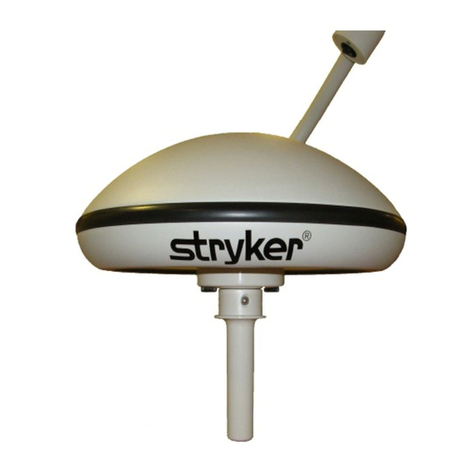
Stryker
Stryker Visum 300 Assembly, operation and maintenance instructions
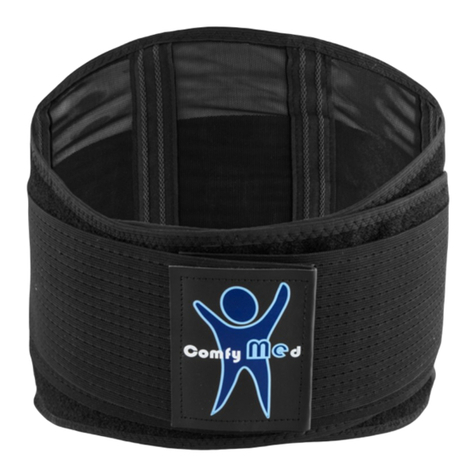
Comfy Med
Comfy Med Back Brace CM-SB01 instruction manual
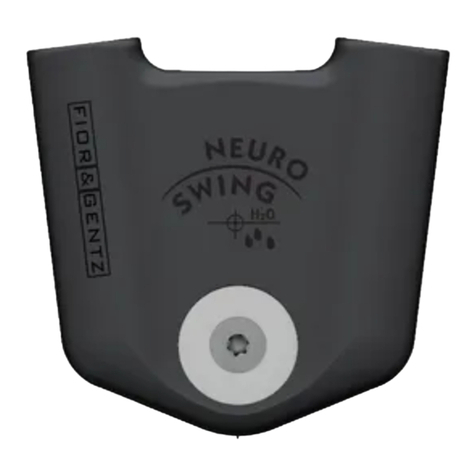
FIOR & GENTZ
FIOR & GENTZ NEURO SWING H2O Instructions for use
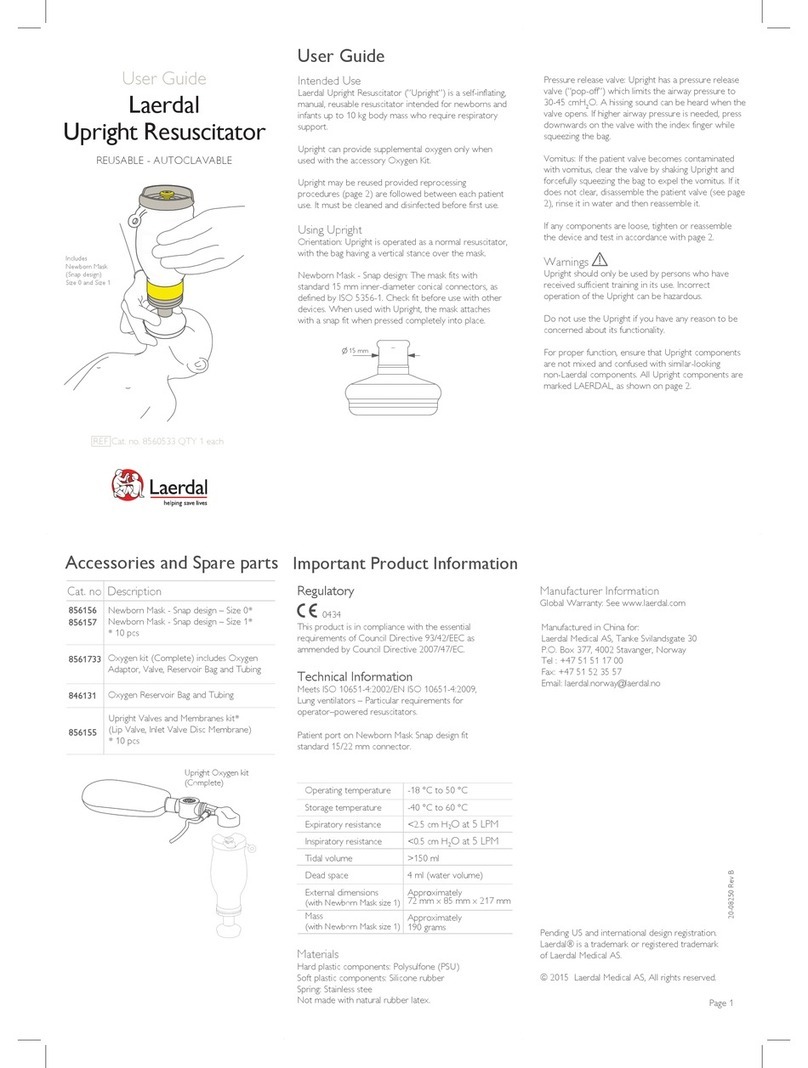
laerdal
laerdal Upright Resuscitator user guide
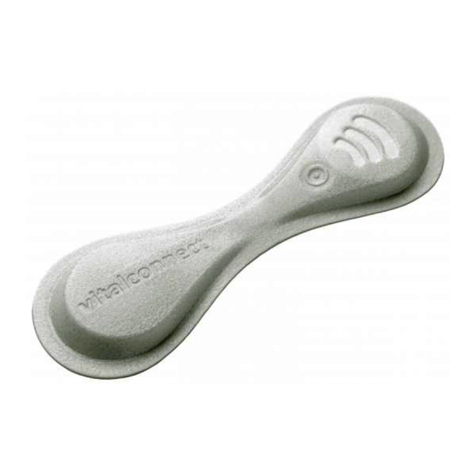
VitalConnect
VitalConnect VitalPatch Let's get started
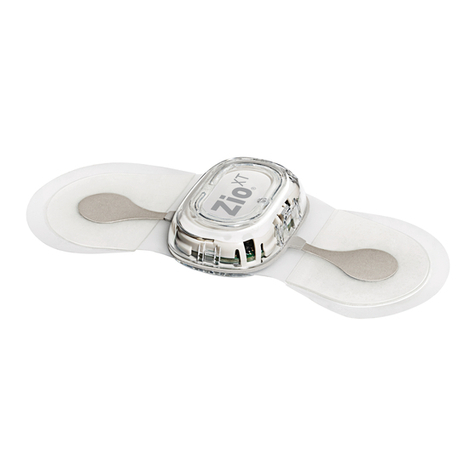
iRhythm
iRhythm ZIO XT PATCH Quick manual
